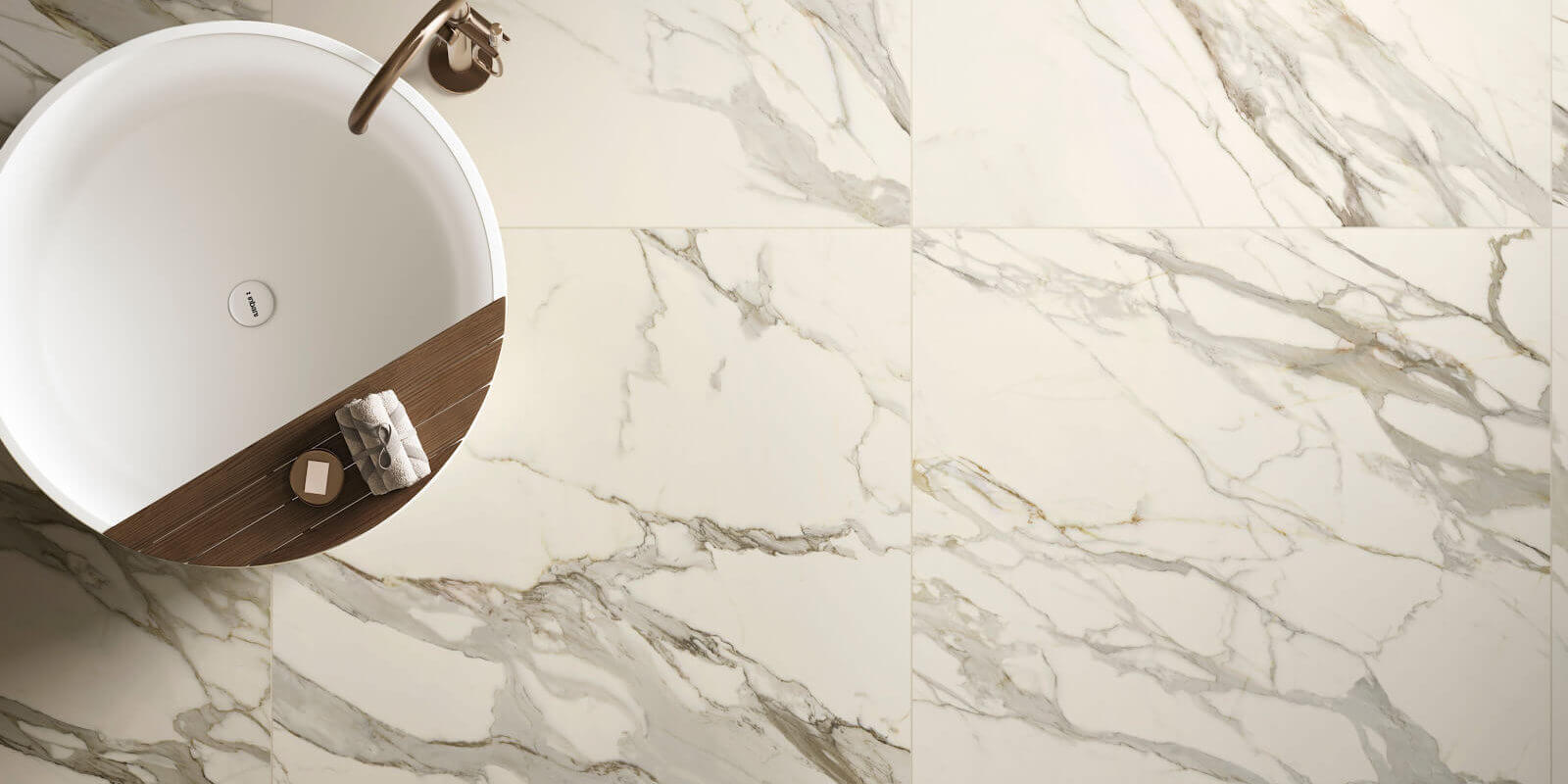Easy Cleaning Tips for Porcelain and Ceramic Tile

Different types of ceramic tile collectively make up the ceramic tile family and all share ceramic tile’s easy-cleaning benefits. Each of the tile subsets is produced slightly differently and may consequently have additional advantages that lend themselves to specific applications. “Ceramic tile” (nonporcelain ceramic tile surfaces, such as quarry tile, regular ceramic tile, pressed floor tile, and wall tile) or “porcelain tile” (porcelain tile surfaces), all offer aesthetic and functional advantages over many nonceramic surface options, including water, stain, and scratch resistance. Pair these benefits with easy maintenance and you have an ideal surface choice from floor to ceiling, inside and out, with options appropriate for different levels of use (residential to heavy industrial).
Spend less time cleaning and more time admiring your beautiful porcelain and ceramic tile surfaces with our easy cleaning tips.
In a Nutshell: A Super-Quick Guide to Cleaning Porcelain and Ceramic Tile Surfaces
Need a quick answer? We’ll get into the whys and wherefores below, but here are some quick, need-to-know tips to clean up your current mess.
Low-Maintenance Care
Easy care starts with understanding the numerous low-maintenance and hygienic benefits of porcelain and ceramic tile:
- Bacteria resistance: Porcelain and ceramic tile surfaces are inhospitable to the growth of bacteria and other microbes such as mold.
- Antimicrobial: Options are available with antimicrobial properties that can suppress and even destroy harmful microorganisms, such as mold, fungi, bacteria, and viruses.
- Hypoallergenic: In addition to containing no allergens, porcelain and ceramic tile surfaces are impenetrable by allergens in the environment, including dirt, dust, dust mites, and pollen.
- Water resistance: All porcelain and ceramic tile are water-resistant. Further, porcelain is “impervious” to moisture, meaning it has a water absorption of 0.5% or less.
- Easy cleaning: No harsh chemicals are necessary — usually, water alone is enough.
- Stain and scratch resistance: Porcelain and ceramic tile surfaces are highly resistant to stains, scratches, scrapes, dents, and cuts. Dirt often accumulates in small crevices caused by damage on nonceramic materials.
[Related: Health Benefits of Ceramic Tile]
Porcelain and Ceramic Tile Cleaning Supplies
 Broom or vacuum cleaner
Broom or vacuum cleaner
 Clean water
Clean water
 Clean cloth or mop
Clean cloth or mop
 For occasional deep cleaning, a mildly alkaline detergent (e.g., Mr. Clean, Spic and Span) or a cleaner made specifically for tile and grout
For occasional deep cleaning, a mildly alkaline detergent (e.g., Mr. Clean, Spic and Span) or a cleaner made specifically for tile and grout
 Nylon or plastic scrubbers
Nylon or plastic scrubbers
How to Clean Porcelain and Ceramic Tile
Porcelain and ceramic tile surfaces make maintenance easy for you with many easy-care benefits.
You know best how often to clean, whether that means once a week, twice a week, or even every day — after all, it depends on the level of foot traffic in your home, how much you use a space, and if you have any mess-making humans or pets in the house. Where and how your surface is used — such as flooring, countertop, or shower tile — also determines when you need to clean.
For regular light cleaning of porcelain and ceramic surfaces, all you need to do is:
- Sweep: Your first step is to sweep away dust, crumbs, and other debris that have accumulated since your last cleaning. Take this time to sweep or clean any throw rugs. If you’re cleaning a porcelain or ceramic tile counter rather than flooring, simply wipe off crumbs.
- Wipe with water: Next, wipe with clean water. That’s right: water alone is enough to clean lightly soiled porcelain and ceramic tile surfaces. No harsh chemicals are necessary! If you choose to use a mop for your flooring, be sure you have swept up debris beforehand and use a flat mop rather than a sponge mop to keep from pushing dirty water into the grout lines.
- Dry: Dry thoroughly after wiping with water, either by air-drying or using a microfiber cloth (a dry flat mop is great as well).
[Related: How Dirty Are Your Carpets? A Robot Baby Reveals the Ugly Truth]
How to Deep Clean Porcelain and Ceramic Tile
Sweeping and wiping with water may not be enough to clean up every mess that life throws your way. Likewise, periodic deep cleaning is essential to any home cleaning routine.
Deep cleaning means swapping out water for a cleaning solution. Think you already know how to clean and disinfect? A recent study from the Centers for Disease Control and Prevention (CDC) found that one-third of Americans are cleaning wrong, so listen up: The best cleaners for porcelain and ceramic tile are those that are formulated especially for tile and grout. Makes sense, right?
When you can’t find a tile-specific cleaning product, look for a pH-neutral cleaner or slightly alkaline cleaner, such as Spic and Span or Mr. Clean. Don’t use oil- or wax-based cleaners because they leave a residue on your surfaces that may attract dirt more readily. For more information on different types of cleaners and what’s recommended, scroll down.
A little elbow grease may also be all that’s necessary for tough-to-remove spills and messes. Plastic and nylon scrubbers are great for these instances.
Rinse thoroughly with clean, clear water after cleaning to remove any residue from the cleaner. Otherwise, residue will attract dirt and may leave your surface with a dull appearance. Using clean water to rinse the surface is very important, so refill your bucket with new water rather than reusing dirty rinse water.
Dry thoroughly — just give your surfaces a bit of time to air dry or wipe with a clean, dry mop or cloth.
How to Disinfect Porcelain and Ceramic Tile
We may now be more concerned with disinfecting our surfaces than ever before. Porcelain and ceramic tile surfaces don’t require the use of harsh cleaning chemicals, which is an advantage for those of us wanting to keep these substances out of our kitchens. However, note that the occasional use of harsher disinfectants will not dull or damage porcelain or ceramic tile, such as may be the case with many other nonceramic surface materials.
Consult the Environmental Protection Agency’s (EPA’s) list of registered disinfectants when deciding on which to use, and keep in mind that different disinfectants may be more appropriate for fighting specific bacteria or viruses. Be sure to thoroughly rinse away the suds after cleaning to prevent residue from drying on your surfaces.
Note: Always follow the label’s instructions for safe use when cleaning with disinfectants and chemicals, such as ensuring proper ventilation and wearing gloves.
[Related: Post-Pandemic Dream Kitchen Guide]
How to Clean Textured Porcelain and Ceramic Tile
Do you have textured tile? If you’re not sure if your tile is textured or not, just reach out and touch it! Textured tile may have a three-dimensional surface, so you may feel rising and falling slopes, angles, ridges, or other convex and concave spaces.
You can clean textured tile the same way you would clean regular porcelain and ceramic surfaces, with just a couple extra steps:
- When sweeping, sweep in two directions: first in the direction of the tile and then diagonally.
- When mopping, wiping, or scrubbing, follow the same two-direction process. For highly textured or rough tile, scrubbing with a brush will be more effective than wiping with a cloth.
[Related: Tile Trend Ideas: Gauged Porcelain Tile]
How to Clean Grout
It’s logical that you will clean your grout at the same time that you clean your tile, without any extra steps. However, grout may develop stains or other issues over time that require a little extra care:
- How to deep clean grout: Scrub the grout using a grout brush (or an old toothbrush) and a cleaner specifically formulated for tile and grout. If possible, vacuum up the dirty water with a wet-dry vacuum to lift the dirt off the joint. Then rinse with clean water and vacuum that up as well to remove any residual soap. (If you don’t have access to a wet-dry vacuum, thoroughly rinse with clean water and dry the grout with a towel.)
- How to remove stains from grout: Tough stains may be simple to remove with a steam cleaner. The pressurized steam brings the stains to the grout’s surface, where you can more easily scrub them away.
- How to prevent grout from staining: Many grouts are now self-sealing to protect against staining. If you are using a cementitious grout that isn’t a self-sealing grout, seal it after installation and then regularly reseal to maintain the stain and moisture resistance, decrease maintenance, and help the grout retain its original color. See the sealer’s product information for instructions. Note: Epoxy grout does not require sealing.
- How to remove mold or mildew from grout: Porcelain and ceramic tile’s hard-fired surface makes it inert and inhospitable to bacteria, mold, and mildew. However, a breakdown in your grout’s sealant could allow water, soap, and oily dirt into the subsurface and lead to bacteria growth. If you use an alkaline cleaner such as bleach for a rare deep cleaning, you should thoroughly rinse the area, dry the grout thoroughly, and apply a sealer within 24 hours to prevent future mold and mildew growth. Note: Porcelain and ceramic surfaces are bleach-safe and will not be harmed or fade from bleach as with some other nonceramic surface materials.
Pro tip: If you are not able to remove a stain or you want to replace your grout with self-sealing grout, you can remove the existing grout and regrout. Consult with an expert before taking any action. Never grout directly over old grout without removing it first.
Types of Tile and Grout Cleaners
Cleaners fall into three categories: alkaline (cleaners with a pH above 7), acidic (cleaners with a pH below 7), and neutral (cleaners with a pH of 7). Prolonged use of cleaners that are highly alkaline (products with a high pH like un-diluted household bleach) or highly acidic (products with a low pH like vinegar) may break down some sealers which are there to help prevent soap scum, oils, and dirt from penetrating into the grout. If use of highly acidic or alkaline cleaners is needed, consult with the grout manufacturer for their recommendations.
- Alkaline cleaners: Use this type of cleaner when you need to remove stubborn grease or other substances that will not come off with water alone. While highly alkaline cleaners may not harm tile or grout when used occasionally, they can strip away sealant from the grout over time and you may need to eventually rejuvenate your sealant. Highly alkaline cleaners may also chemically burn your skin so wear gloves and avoid splashing. With a pH of 12, un-diluted household bleach is an example of an alkaline cleaner and should not be used on tile and grout on a regular basis. For cleaning and sanitizing, the CDC recommends a dilution of one cup of bleach to five gallons of water. Diluting bleach decreases the alkalinity and is safe for regular use on all types of porcelain and ceramic tile surfaces. Thoroughly rinse any cleaner from the surface and do not allow residue to dry on the tile and grout.
- Acidic cleaners: Highly acidic cleaners are corrosive but in a different way than highly alkaline cleaners. Since cement grout is alkaline, the acid reacts with it and dissolves a thin layer on top, exposing clean grout below. While these cleaners may appear to “clean,” most manufacturers do not recommend them because of their eroding effect on grout. Acidic tile and grout cleaners should only be used by professionals when removing and replacing grout.
- Neutral cleaners: Neutral solutions with a pH of 7 (just like water) are preferred for tile and grout. Consider cleaners made specifically for tile and grout first or turn to a mildly alkaline detergent (i.e. Mr. Clean, Spic and Span). Note, neutral cleaners are the only cleaners recommended for colored grout.
Takeaways: Neutral cleaners made specifically for tile and grout are the best option for cleaning when water alone won’t work. If neutral cleaners aren’t strong enough, try a mildly alkaline detergent — but never an acidic cleaner.
For a list of companies that manufacture cleaners designed specifically for tile and grout, visit the Tile Council of North America (TCNA).
A Clean Home Is a Happy Home
Not many of us love to clean, but the old refrain is true: A clean home is a happy home — and a healthy home. Keep your house clean and your porcelain and ceramic tile looking brand-new by cleaning regularly, following these easy steps, and sticking with recommended cleaners.
Not sure if you’ll remember everything? Print out our downloadable cleaning tips and tuck them near your cleaning supplies — a good reminder to clean regularly and clean well!


